From Hiroshige’s Edo Hyaku to Catfish Prints
A report of the past projects and an announcement of upcoming collaborative projects/public programs between Royal Ontario Museum and The Japan Foundation, Toronto
One Hundred Famous Views of Edo 名所江戸百景
(Meisho Edo Hyakkei), in shortened form “Edo Hyaku”, is a series of over one hundred woodblock prints designed by UTAGAWA Hiroshige (1797–1858), which began to be published in 1856 and was completed in 1859 after Hiroshige’s death. Over one hundred views of Edo (modern-day Tokyo) in a monumental series from the final years of Hiroshige’s life. Distinctive style of landscape in portrait format.
The Japan Foundation, Toronto has been privileged to work with this magnificent masterpiece, bringing it to Canada over a challenging time of pandemic.
One Hundred Famous Views of Edo
Landmarks From Before It Was Called Tokyo: Hiroshige’s One Hundred Famous Views of Edo
An exhibition co-presented by Stuart Jackson Gallery & The Japan Foundation, Toronto
♦ January 18 – April 13, 2019
The compassion and nostalgic affection of Hiroshige for his own home town of Edo, (now known as Tokyo) is evident in the Edo Hyaku print series. A previous exhibition at The Japan Foundation, Toronto in 2019 of “Edo Hyaku” approached this masterpiece from the viewpoint of its serene, poetic expressions, which were based on Hiroshige’s emotional input to his own city. The exhibition focused on the theme of snow and moon, displaying other Edo city portrayal pieces by Hiroshige. From a collection of Stuart Jackson Gallery, the precious original Hiroshige prints of city-and-landscape views of Edo were exhibited.
Hiroshige’s “Edo Hyaku”: Perspectives of Landscape Ukiyo-e Prints in Portrait Layout
An exhibition presented by The Japan Foundation, Toronto
♦ October 12 – December 16, 2021; February 22 – April 21, 2022
In order to cover the huge amount of works omitted from our previous exhibition, we switch our focus to cherry blossoms and boats on water. We are also examining Hiroshige’s final years, which is characterized by the use of the tall portrait layout in landscape paintings. Linear perspective and the expression of depth and distance are the keys to unfold the visual wealth of Hiroshige’s late pieces.
A masterpiece of this period, consisting of a trio of triptychs known as Snow, Moon, and Flower (1857), is on display, along with pieces from the series Famous Views of the Sixty-odd Provinces (1853–56).
The artworks on display are re-conceived prints, i.e. reproductions, not off-set prints from photography, but re-carved and hand-printed in the traditional method based on historical research.
Hiroshige’s “Edo Hyaku”: Perspectives of Landscape Ukiyo-e Prints in Portrait Layout
With Originals from Royal Ontario Museum
An exhibition in two parts presented by The Japan Foundation, Toronto
♦ July 2022 – October 2022: Part I
♦ October 2022 – January 2023: Part II
Returning exhibitions of Edo Hyaku will be empowered by the originals on special loan from Royal Ontario Museum. The exhibition will be re-arranged with new themes: Boats and Bridges for Part I, Residents and City Streets of Edo for Part II. We are increasingly aware that “Edo Hyaku” was most likely produced as a disaster relief effort for the Ansei Great Earthquakes of 1855.
Namazu-e, Catfish Prints Projects
Research Project & Public Events. Co-presented by Royal Ontario Museum & The Japan Foundation, Toronto
♦ Fall 2021 – Fall 2022
Royal Ontario Museum’s exceptional holdings of an album of Japanese namazu-e prints — or “catfish pictures” — were created and published in response to the Ansei Great Earthquakes that struck and heavily damaged Edo in 1855.
The projects present unique opportunities to bring people together through images that exemplify the resilience of the human and creative spirit. The prints from this album will be published as an online exhibition for broad audiences, while also enriching in-person engagement when these works are potentially presented at public events.
This project started with the following research component.
- Collection Digitalization (Completed, January 2022)
- All 87 images contained in ROM’s namazu-e album have been digitally captured.
In addition to making this album accessible online for both public and scholarly audiences around the world, associated educational programming based on these prints will create engaging opportunities for learners of all ages and diverse backgrounds to explore the art and culture of Japan. The digitalized material will be foundational to the following two public offerings.
- Online Exhibition (In production, available to public, Fall 2022)
Selected prints from the album of namazu-e prints will be co-presented by ROM and the Japan Foundation as an online exhibition on the Google Arts and Culture platform. Dr. Akiko Takesue, Bishop White Committee Associate Curator of Japanese Art & Culture has been working with curators of fishes and climate change on the content and ROM interpretive planner to structure information as an engaging experience that will have relevance for all users.
- Learning programs, (Available to public, Fall 2022)
New virtual schools visit module and interdisciplinary public programs based on Japanese namazu-e prints will be developed and delivered for a wide range of visitors, Grade K-12 and Adult. The programs will introduce visitors to catfish in Japanese folklore and popular reactions to the Ansei Great Earthquakes of 1855. The Edo Hyaku, or One Hundred Famous Views of Edo series, which is considered to embody a celebration of the restoration of the city that had been devastated by the same natural disaster, will be linked to namazu-e prints in the programs.
♦ Sneak previews of Catfish and Earthquake Prints
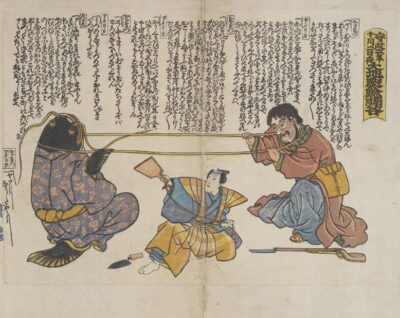
2004.38.1.78: Neck-pulling game between the earthquake catfish and Commodore Matthew Perry. Courtesy of the Royal Ontario Museum, © ROM. This print humourously illustrates the growing social anxiety at that time caused by the American “Black Ship” arrived in Japan in 1853 and the Ansei Great Earthquake in 1855.
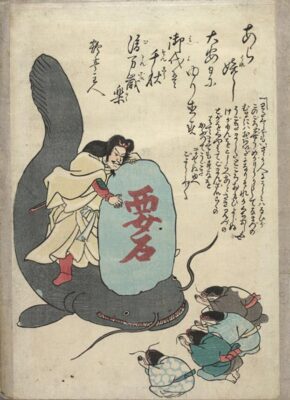
2004.38.1.48: Untitled (Kashima Deity pressing Kaname-ishi down on catfish). Courtesy of the Royal Ontario Museum, © ROM. A giant catfish is pressed down by the Kashima deity with the Kaname-ishi stone, with four smaller catfish in kimono begging for forgiveness. This image provided Edo townspeople a sense of security that another earthquake would not happen again.
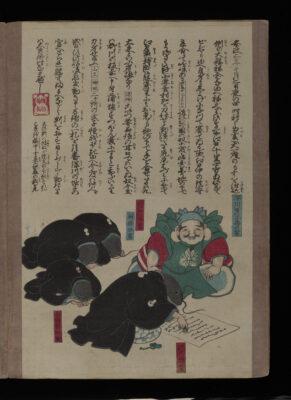
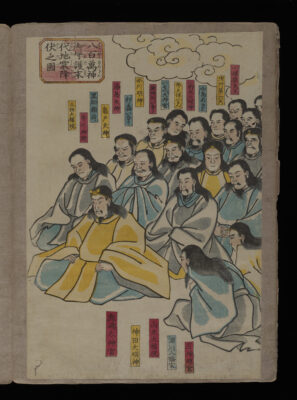
2004.38.1.16 and 2004.38.1.57: Earthquake Yielding to Eight Million Deities. Courtesy of the Royal Ontario Museum, © ROM. This two-sheet print depicts the assembled Deities of Edo led by the Kashima deity in a yellow robe receiving a formal apology from four namazu who were responsible for the Ansei Great Earthquake in 1855 and earlier earthquakes, all in montsuki, the formal kimono.
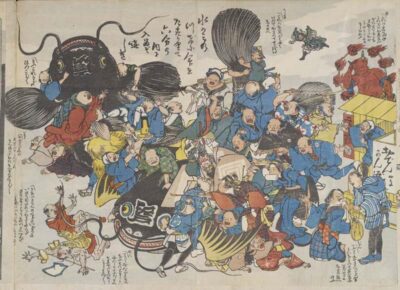
2004.38.1.35: Untitled (People chastising two giant catfish). Courtesy of the Royal Ontario Museum, © ROM. This two-sheet print illustrates two giant catfish being chastised by angry townspeople who suffered from the earthquake. On a closer look, some people are just observing and others are trying to stop the punishment—because they are benefitted from the reconstruction boom after the disaster.
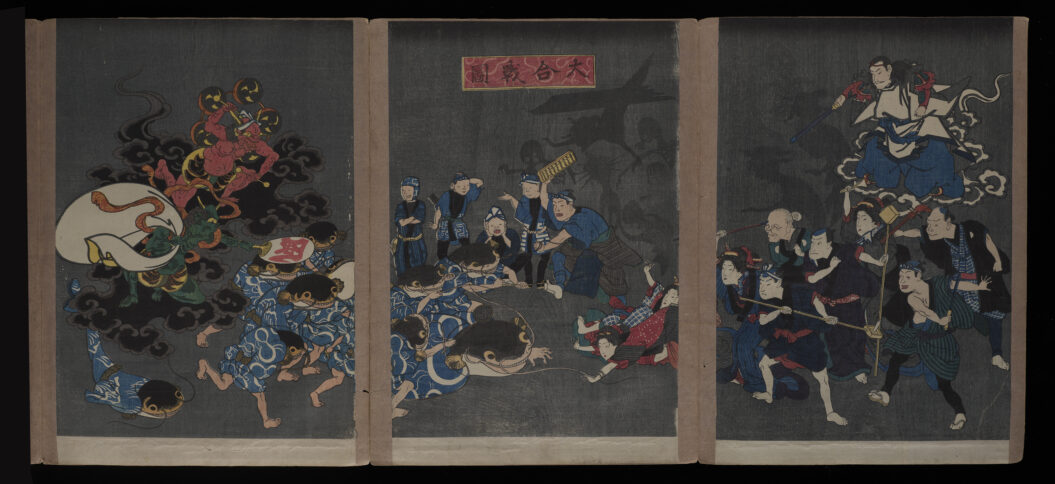
2004.38.1.14: Picture of Big Battle. Courtesy of the Royal Ontario Museum, © ROM. A three-sheet print depicting a battle between a group of catfish supported by gods of thunder and wind, and townspeople suffered from the earthquake supported by Kashima Deity with ghosts behind them. The battle is being observed by smiling people in the middle who are benefitted from the disaster.
